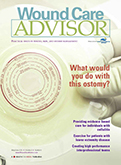Search Results for: ankle
No more skin tears
Imagine watching your skin tear, bleed, and turn purple. Imagine, too, the pain and disfigurement you’d feel.
What if you had to live through this experience repeatedly? That’s what many elderly people go through, suffering with skin tears through no fault of their own. Some go on to develop complications.
A skin tear is a traumatic wound caused by shear, friction, or blunt-force trauma that results in a partial- or full-thickness injury. Skin tears are painful because the precipitating injury commonly involves the dermis, which is rich with nerve endings. (more…)
Read MorePros and cons of hydrocolloid dressings for diabetic foot ulcers
Diabetic foot ulcers stem from multiple factors, including peripheral neuropathy, high plantar pressures, decreased vascularity, and impaired wound healing. Contributing significantly to morbidity, they may cause limb loss and death. (See Foot ulcers and diabetes.)
Initially, hydrocolloid dressings were developed to function as part of the stomal flange. Based on their success in protecting peristomal skin, they were introduced gradually into other areas of wound care. They contain wafers of gel-forming polymers, such as gelatin, pectin, and cellulose agents, within a flexible water-resistant outer layer. The wafers absorb wound exudate, forming a gel and creating a moist healing environment. (more…)
Read MoreBuzz Report: Latest trends, Part 1
We all lead busy lives, with demanding work schedules and home responsibilities that can thwart our best intentions. Although we know it’s our responsibility to stay abreast of changes in our field, we may feel overwhelmed when we try to make that happen.
Keeping clinicians up-to-date on clinical knowledge is one of the main goals of the Wild On Wounds (WOW) conference, held each September in Las Vegas. Each year, I present the opening session of this conference, called “The Buzz Report,” which focuses on the latest-breaking wound care news—what’s new, what’s now, what’s coming up. I discuss innovative new products, practice guidelines, resources, and tools from the last 12 months in skin, wound, and ostomy management. This article highlights the hottest topics from my 2015 Buzz Report. (more…)
Read MoreProviding evidence-based care for patients with lower-extremity cellulitis
By Darlene Hanson, PhD, RN; Diane Langemo, PhD, RN, FAAN; Patricia Thompson, MS, RN; Julie Anderson, PhD, RN; and Keith Swanson, MD
Cellulitis is an acute, painful, and potentially serious spreading bacterial skin infection that affects mainly the subcutaneous and dermal layers. Usually of an acute onset, it’s marked by redness, warmth, swelling, and tenderness. Borders of the affected skin are characteristically irregular. Although cellulitis may occur in many body areas, this article discusses the most common location—the lower limb. (more…)
Read More2015 Journal: May – June Vol. 4 No. 3
Helping patients with lower-extremity disease benefit from exercise
By Jeri Lundgren, BSN, RN, PHN, CWS, CWCN
Research has shown that exercise can help ease symptoms in patients with arterial insufficiency, venous insufficiency, neuropathic disease, or a combination of these conditions. Here’s what you need to know to ensure your patients reap the most benefits from exercise. (more…)
Read MoreRole of rehab in wound care
By Bill Richlen, PT, WCC, DWC, and Denise Richlen, PT, WCC, DCCT
How many times have you heard someone say, “I didn’t know PTs did wound care”? Statements like this aren’t uncommon. The role of physical therapists (PTs), occupational therapists, and speech therapists in wound care is commonly misunderstood by and even a mystery to many clinicians. Sometimes the therapists themselves are confused about reimbursement or what their role on the wound care team can be. (more…)
Read MoreClinical Notes : Diabetes, medical honey, silver dressings, clostridium
Guidelines for optimal off-loading to prevent diabetic foot ulcers
“The management of diabetic foot ulcers through optimal off-loading,” published in the Journal of the American Podiatric Medical Association, presents consensus guidelines and states the “evidence is clear” that off-loading increases healing of diabetic foot ulcers.
The article calls for increased use of off-loading and notes that “current evidence favors the use of nonremovable casts or fixed ankle walking braces as optimum off-loading modalities.” The authors reviewed about 90 studies. (more…)
Read MoreClinician Resources: MRSA, Dosing Calculator, CDC Resources
When should we take “No” for an answer?
By: Donna Sardina, RN, MHA, WCC, CWCMS, DWC, OMS
Have you ever had a patient yell “Get out of my room!” or “Don’t touch me! I don’t want to be turned”? How about “No! Don’t put those compression stockings on my legs!” or “No, I’m not going to wear those ugly orthopedic shoes!” or “No way. I can’t stay in bed. I have to go to Bingo!”?
As clinicians, our first instinct usually is paternalistic, as if we’re the patient’s parent who knows what’s best for our child. We think, “Sorry, but you have to do this. It’s for your own good.” And we convey that idea to the patient. (more…)
Read MoreClinical Notes: Aspirin, Skin Infections, NPWT surgical incisions
Aspirin inhibits wound healing
A study in the Journal of Experimental Medicine describes how aspirin inhibits wound healing and paves the way for the development of new drugs to promote healing.
The authors of “12-hydroxyheptadecatrienoic (12-HHT) acid promotes epidermal wound healing by accelerating keratinocyte migration via the BLT2 receptor” report that aspirin reduced 12-HHT production, which resulted in delayed wound closure in mice. However, a synthetic leukotriene B4 receptor 2 (BLT2) agonist increased the speed of wound closure in cultured cells and in diabetic mice. (more…)
Read More




